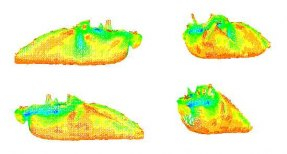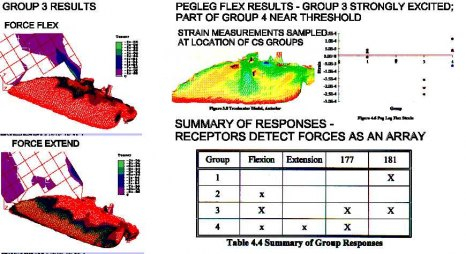Introduction
Arthropod nervous systems efficiently integrate diverse sensory information to produce remarkable locomotion abilities. Engineers/Biologists can derive control and biomechanical principles from insects to solve legged locomotion. Force information is essential in control of insect walking. Forces are monitored by sense organs through strains in the exoskeleton. Classic experiments in stick insects demonstrated the importance of trochanteral receptors in walking. Partial leg ablation causes loss of tripod gait. Attachment of prosthesis that permits contact and force development restores leg use.
Goals
- To develop a method to create models of shell-like structures to study the effects of force application and distribution of resultant strains
- Method used to generate a Finite Element Model (FEM) of the trochanter of Periplaneta Americana (American Cockroach) and Blaberus Discoidalis(Deathhead Cockroach)
- Examine effects of force application on the Campaniform Sensilla (strain measuring sensor and transducer structure) using a ‘peg leg’ paradigm
The Trochanter
The trochanter is approximately 2.5 mm in length for the adult Periplaneta Americana. The outer surface is smooth, and the inner surface has a variable topology. The coxa attaches to the trochanter via 2 condyles on the anterior and posterior sides. The femur attaches to the trochanter via 2 condyles on the distal anterior surface.
A Campaniform Sensillum (CS) has a single neuron that inserts into an ellipsoidal cuticular cap (long axis length 6 to 24mm) on the surface of the exoskeleton. The CS are directionally sensitive. They respond to cuticular compressive strains perpendicular to the long axis.
CS are found in 6 groups on the leg (10-15 in a group). The CS are similarly oriented within a group. Out of these 6 groups, 4 are located on the trochanter. Groups 2,3 and 4 are located on the anterior surface while Group 1 is located posteriorly.
Modeling
Confocal Microscopy done at Marshall University is used to reproduce the 3D structure of the trochanter. The trochanter is optically sectioned by imaging endogenous fluorescence and series of indexed images are obtained. The confocal model is created in Voxblast software and a surface extraction is performed using a sampling algorithm.
3-D image editing software exports the raster confocal model into a proprietary vector image format. Vector data is similar to a FE mesh, but is inappropriate because of element arrangement, shape and size. There is also no control over the mesh density.
Custom code was created by Clay Flanningan to automatically generate the mesh from the vector data file. Coordinate data representing the entire surface is extracted and resampled to created FE nodes. About 500,000 nodal points are resampled to give a CAD model with 5000 appropriately oriented FE nodes and thickness values.
Cuticular properties
Cuticular test have indicated a Hepburn and Joffe elastic modulus of 3160 N/mm2 for the hind femur of cockroach. Poisson’s ratio has not been experimentally tested, as such a typical value between 0.25-0.33 such as 0.30 was used.
Forced Flexion Experiments
Responses of the trochanteral CS are tested by bending the femur with the joint movement blocked. Forced Flexion reflexively excites the slow extensor motoneuron (Ds). Pearson has postulated that this reflex functions as a positive feedback to enhance the leg extensor activity in stance. The Finite Element Model is used to test responses of different groups of CS to leg loading and muscle contractions.
A low – resolution femur is added to the trochanter model to accurately apply environmental forces. The trochanter is fixed and a 1.96 mN force is applied to the distal femur dorsally. For each group, the magnitude of compression oriented along short axis of campaniform sensilla is measured.
Sensitivity of CS through biological experiments have been obtained as 20 mm strain by Barth measuring slit sensilla and 50mm strain by Zill ENG readings during forced flexion.
Results
The combined response of all four trochanteral groups is necessary to differentiate loading conditions. Using these set of trochanteral CS excitations, it is now possible to predict the physical loads that would cause any set of trochanteral excitations.
Smooth Model
To test the effects of internal ridges on CS responses, an FEA model was generated from the confocal reconstruction with walls of uniform thickness. The same experiments were carried out on this model. It was understood that the major effect of the ridges was structural and much greater concentrations of strains occurred in the smooth model.
Normal operating stress from forced flexion was about 6 MPa. The maximum stress in the trochanter was 45 Mpa. It can therefore that when the Periplaneta Americana locomotes, it operates within the linear range of cuticle properties.


